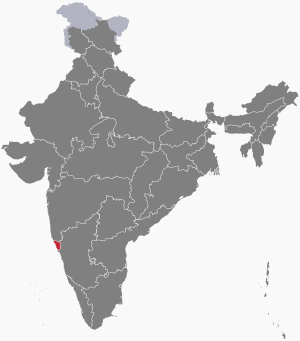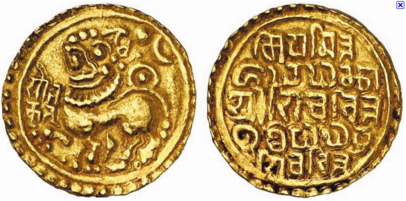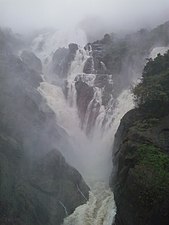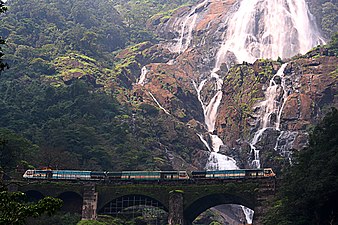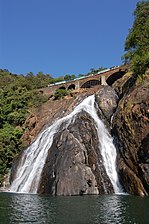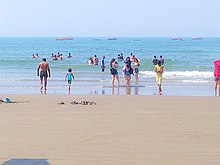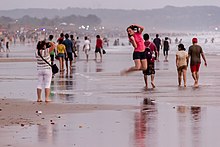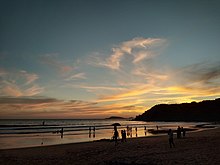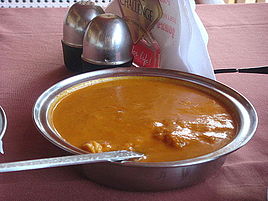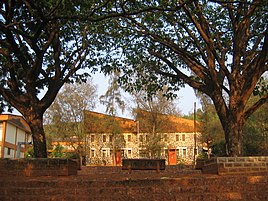Goa
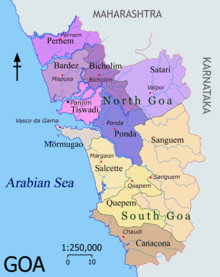
Goa(Konkani pronunciation:[ɡõːj],Portuguese:[ˈɡoɐ]) is astateon the southwestern coast ofIndiawithin theKonkanregion, geographically separated from theDeccan highlandsby theWestern Ghats.[9][10]It is bound by theIndianstates ofMaharashtrato the north, andKarnatakato the east and south, with theArabian Seain the west. It is India's smallest state by area andfourth-smallest by population.Goa has the highestGDP per capitaamong all Indian states,[6][11]two and a half times as high as the GDP per capita of the country as a whole.[12]TheEleventh Finance Commissionof India named Goa the best-placed state because of its infrastructure, and India'sNational Commission on Populationrated it as having the best quality of life in India (based on the commission's "12 Indicators" ).[12]It is thesecond-highest rankingamong Indian states in thehuman development index.[7]
Panajiis the state's capital, whileVasco da Gamais its largest city. The historic city ofMargãoin Goa still exhibits the cultural influence of thePortuguese,whofirst voyaged to the subcontinentin the early 16th century as merchants, andconqueredit soon thereafter, whereupon Goa became anoverseas territory of the Portuguese Empire,part of what was then known asPortuguese India,and remained as such for about 456 years until it wasannexed by Indiain 1961.[13][14]Goa's official language, which is spoken by a majority of its inhabitants, isKonkani.
Goa is visited by large numbers of international and domestic tourists each year because of its white-sand beaches, active nightlife, places of worship, andWorld Heritage-listed architecture.It also has rich flora and fauna because it lies very close to theNorth Western Ghats rainforests,one of the rarebiodiversity hotspotsof the world.
Etymology
[edit]After theBahmani-Bijapuricity of Goa was captured byAfonso de Albuquerquein AD 1510, and made the capital of theEstado da Índia,the city gave its name to the contiguous territories.[citation needed]
The origin of the city name "Goa" is unclear. In ancientliterature,Goa was known by many names, such asGomanchala,Gopakapattana,Gopakapattam,Gopakapuri,Govapuri,Govem,andGomantak.[15]Other historical names for Goa areSindapur,Sandabur,andMahassapatam.[16]
History
[edit]Prehistory
[edit]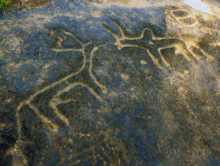
Rock art engravings found in Goa are one of the earliest known traces of human life in India.[17]Goa, situated within the Shimoga-Goa Greenstone Belt in theWestern Ghats(an area composed ofmetavolcanics,iron formations and ferruginous quartzite), yields evidence forAcheuleanoccupation.[18]Rock artengravings (petroglyphs) are present on laterite platforms and granite boulders inUsgalimalnear the west flowingKushavati riverand in Kajur.[19]In Kajur, the rock engravings of animals, tectiforms and other designs in granite have been associated with what is considered to be a megalithic stone circle with a round granite stone in the centre.[20]Petroglyphs,cones, stone-axe, and choppers dating to 10,000 years ago have been found in various locations in Goa, including Kazur, Mauxim, and theMandovi-Zuaribasin.[21]Recently these petroglyphs have been included in the tentativelist of UNESCO world heritage sites.
Evidence ofPaleolithiclife is visible at Dabolim, Adkon, Shigao, Fatorpa, Arli, Maulinguinim, Diwar, Sanguem, Pilerne, and Aquem-Margaon. Difficulty incarbon datingthe laterite rock compounds poses a problem for determining the exact time period.[22]
Early Goan society underwent radical change whenIndo-AryanandDravidianmigrants amalgamated with the aboriginal locals, forming the base of early Goan culture.[23]
Early history
[edit]In the 3rd century BC, Goa was part of theMaurya Empire,ruled by the Buddhist emperor,AshokaofMagadha.Buddhist monks laid the foundation ofBuddhismin Goa. Between the 2nd century BC and the 6th century AD, Goa was ruled by theBhojas of Goa.ChutusofKarwaralso ruled some parts asfeudatoriesof theSatavahanasofKolhapur(2nd century BC to the 2nd century AD),Western Kshatrapas(around 150 AD), theAbhirasof Western Maharashtra,Bhojas of Goa,and theKonkan Mauryasas feudatories of theKalachuris.[24]The rule later passed to the Chalukyas ofBadami,who controlled it between 578 and 753, and later theRashtrakutasofMalkhedfrom 753 to 963. From 765 to 1015, the SouthernSilharasofKonkanruled Goa as the feudatories of the Chalukyas and the Rashtrakutas.[25]Over the next few centuries, Goa was successively ruled by theKadambasas the feudatories of theChalukyas of Kalyani.They patronisedJainism in Goa.[26]
In 1312, Goa came under the governance of theDelhi Sultanate.The kingdom's grip on the region was weak, and by 1370 it was forced to surrender it toHarihara Iof theVijayanagara Empire.The Vijayanagara monarchs held on to the territory until 1469 when it was appropriated by theBahmani sultansofGulbarga.After that dynasty crumbled, the area fell into the hands of theAdil ShahisofBijapur,who established as their auxiliary capital the city known under the Portuguese asVelha Goa(or Old Goa).[27]
-
TheMahadev Temple,attributed to theKadambas of Goa,in what is todayBhagwan Mahaveer Sanctuary and Mollem National Park
-
Gold coins issued by the Kadamba king of Goa, Shivachitta Paramadideva,c.1147–1187 CE
Portuguese period
[edit]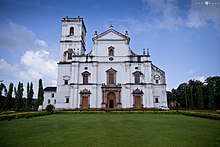
In 1510, the Portuguese defeated the ruling Bijapur sultanYusuf Adil Shahwith the help of a local ally, Thimmayya[28]orTimoji,aprivateer.[29]They set up a permanent settlement inVelha Goa(Old Goa). This was the beginning ofPortuguese colonial rulein Goa that would last for four and a half centuries, until itsannexation by India in 1961.TheGoa Inquisition,a formal tribunal, was established in 1560, and was finally abolished in 1812.[30]
From the latter decades of the eighteenth century, the territory of Goa was composed of two segments: the central nucleus of theVelhas Conquistas(Old Conquests)—Bardes, Ilhas de Goa, and Salcette—which territories had been under Portuguese administration since the sixteenth century; and theNovas Conquistas(New Conquests)—Bicholim, Canacona, Pernem, Quepem, Sattari, and Sanguem—territories which had been successively added through the eighteenth century.[citation needed]
In 1787, Goa experienced its first revolt from its Catholic elite, with thePinto Revoltled by a Goan noble family who revolted against the Portuguese due to racial discrimination in administration and clergy. They were betrayed by a member of the revolt. The Portuguese government executed some of the family members, while others, such asAbbe Faria,went on to join theFrench Revolution.This remains legend in Goa today.

In 1843, the Portuguese moved the capital to theCidade da Nova Goa(City of New Goa), today known asPanaji(Panjim), fromVelha Goa(Old Goa). By the mid-18th century, Portuguese expansions lost other possessions in India until their borders stabilised and formed theGoa, Daman and Diu,which includedSilvassaprior to the Annexation, it was known asEstado da ÍndiainPortuguese,that is the "State of Portuguese India".[citation needed]
Some wealthy Goanzamindarssuch asBaron DempoandViscount Deshprabhuwere included in thePortuguese nobility.[citation needed]
Contemporary period
[edit]AfterIndia gained independencefromBritish rulein 1947, India requested that Portuguese territories on the Indian subcontinent be ceded to India. Portugal refused to negotiate on the sovereignty of its Indian enclaves. On 19 December 1961, the Indian Army invaded withOperation Vijayresulting in theannexation of Goa,and ofDaman and Diuislands into the Indian union.Goa, Daman and Diu,were organised as a single centrally administeredunion territoryof India.[31]On 16 January 1967 areferendumwas held in Goa, to decide the future of the Union Territory ofGoa, Daman and Diu.It was the only referendum to have been held in independent India. The referendum offered the people of Goa a choice between continuing as aunion territoryor merging with the state ofMaharashtraand the majority chose the former.[32][33][34]On 30 May 1987, the union territory was split, and Goa was made India's twenty-fifth state, with Daman and Diu remaining a union territory.[35]
Geography
[edit]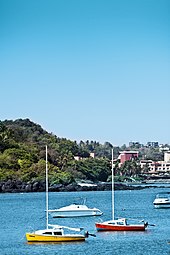

Goa encompasses an area of 3,702 km2(1,429 sq mi). It lies between the latitudes 14°53′54″ N and 15°40′00″ N and longitudes 73°40′33″ E and 74°20′13″ E.[citation needed]
Goa is a part of the coastal country known as theKonkan,which is an escarpment rising up to the Western Ghats range of mountains, which separate it from theDeccan Plateau.The highest point is theSonsogorPeak, with an altitude of 1,026 m (3,366 ft). Goa has a coastline of 160 km (99 mi).[citation needed]
Goa's seven major rivers are theMandovi,Zuari,Terekhol,Chapora,Galgibag, Cumbarjua canal, Talpona, and theSal.[36]The Zuari and the Mandovi are the most important rivers, interspaced by the Cumbarjua canal, forming a major estuarine complex.[36]These rivers are fed by the Southwest monsoon rain and their basin covers 69% of the state's geographical area.[36]These rivers are some of the busiest in India. Goa has more than 40 estuarine, eight marine, and about 90 riverine islands. The total navigable length of Goa's rivers is 253 km (157 mi). Goa has more than 300 ancient water tanks built during the rule of the Kadamba dynasty and over 100 medicinal springs.[citation needed]
Mormugao harbour on the mouth of theZuari riveris considered one of the best natural harbours in South Asia.[citation needed]
Most of Goa's soil cover is made up oflateritesrich in ferric-aluminum oxides and reddish in colour. Further inland and along the riverbanks, the soil is mostlyalluvialandloamy.The soil is rich in minerals and humus, thus conducive to agriculture. Some of the oldest rocks in the Indian subcontinent are found in Goa betweenMolemandAnmodon Goa's border withKarnataka.The rocks are classified asTrondjemeitic Gneissestimated to be 3,600 million years old, dated byrubidium isotope dating.A specimen of the rock is exhibited atGoa University.[citation needed]
- Dudhsagar FallsatBhagwan Mahaveer Sanctuary and Mollem National Park
-
Dudhsagar Waterfalls in August
-
Train passing next to the Dudhsagar Falls
-
Lower half of Dudhsagar Falls
Climate
[edit]Goa features atropical monsoon climateunder theKöppen climate classification.Goa, being in the torrid zone and near theArabian Sea,has a hot and humid climate for most of the year. The month of May is usually the hottest, seeing daytime temperatures of over 35 °C (95 °F) coupled with high humidity. The state's three seasons aresouthwest monsoonperiod (June–September), post-monsoon period (October–January), and pre-monsoon period (February–May).[36]Over 90% of the average annual rainfall (3,048 mm or 120 in) is received during the monsoon season.[36]
| Climate data for Goa | |||||||||||||
|---|---|---|---|---|---|---|---|---|---|---|---|---|---|
| Month | Jan | Feb | Mar | Apr | May | Jun | Jul | Aug | Sep | Oct | Nov | Dec | Year |
| Mean daily maximum °C (°F) | 31.6 (88.9) |
31.5 (88.7) |
32.0 (89.6) |
33.0 (91.4) |
33.0 (91.4) |
30.3 (86.5) |
28.9 (84.0) |
28.8 (83.8) |
29.5 (85.1) |
31.6 (88.9) |
32.8 (91.0) |
32.4 (90.3) |
31.3 (88.3) |
| Daily mean °C (°F) | 26.0 (78.8) |
26.3 (79.3) |
27.7 (81.9) |
29.3 (84.7) |
30.0 (86.0) |
27.6 (81.7) |
26.7 (80.1) |
26.4 (79.5) |
26.9 (80.4) |
27.9 (82.2) |
27.6 (81.7) |
26.6 (79.9) |
27.4 (81.4) |
| Mean daily minimum °C (°F) | 19.6 (67.3) |
20.5 (68.9) |
23.2 (73.8) |
25.6 (78.1) |
26.3 (79.3) |
24.7 (76.5) |
24.1 (75.4) |
24.0 (75.2) |
23.8 (74.8) |
23.8 (74.8) |
22.3 (72.1) |
20.6 (69.1) |
23.2 (73.8) |
| Averageprecipitationmm (inches) | 0.2 (0.01) |
0.1 (0.00) |
1.2 (0.05) |
11.8 (0.46) |
112.7 (4.44) |
868.2 (34.18) |
994.8 (39.17) |
512.7 (20.19) |
251.9 (9.92) |
124.8 (4.91) |
30.9 (1.22) |
16.7 (0.66) |
2,926 (115.2) |
| Average precipitation days | 0.0 | 0.0 | 0.1 | 0.8 | 4.2 | 21.9 | 27.2 | 13.3 | 13.5 | 6.2 | 2.5 | 0.4 | 90.1 |
| Mean monthlysunshine hours | 313.1 | 293.8 | 291.4 | 288.0 | 297.6 | 126.0 | 105.4 | 120.9 | 177.0 | 248.0 | 273.0 | 300.7 | 2,834.9 |
| Source 1:World Meteorological Organization[37] | |||||||||||||
| Source 2:Hong Kong Observatory[38]for sunshine and mean temperatures | |||||||||||||
Subdivisions
[edit]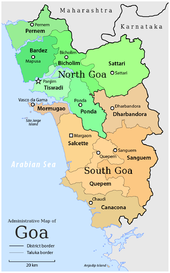
The state is divided into twocivil districts—North GoaandSouth Goa.Each district is administered by aDistrict Collector,appointed by theGovernment of India.[citation needed]
Panaji(Panjim) is the headquarters of North Goa district and is also the capital of Goa. North Goa is further divided into three subdivisions—Panaji,Mapusa,andBicholim;and fivetalukas(subdistricts)—Tiswadi(Panaji),Bardez(Mapusa),Pernem,Bicholim,andSattari(Valpoi).Margao(Madgaon) is the headquarters of the South Goa district. It is also the cultural and commercial capital of Goa. South Goa is further divided into five subdivisions—Ponda,Mormugao-Vasco,Margao,Quepem,andDharbandora;and seventalukas—Ponda,Mormugao,Salcete(Margao),Quepem,andCanacona(Chaudi),Sanguem,andDharbandora.[citation needed]
Goa's major cities are—Panaji,Margao,Vasco-Mormugao,Mapusa,Ponda,Bicholim,andValpoi.Panaji(Panjim) has the onlyMunicipal Corporationin Goa.[citation needed]There are thirteenMunicipal Councils—Margao, Mormugao (merged with Vasco), Pernem, Mapusa, Bicholim,Sanquelim,Valpoi, Ponda,Cuncolim,Quepem,Curchorem,Sanguem, and Canacona. Goa has a total number of 334 villages.[39]
Government and politics
[edit]
The politics of Goa are a result of the uniqueness of this region due to 450 years of Portuguese rule, in comparison to three centuries of British rule experienced by the rest of India. TheIndian National Congresswas unable to achieve electoral success in the first two decades after the State's incorporation into India.[40]Instead, the state was dominated by the regional political parties likeMaharashtrawadi Gomantak Partyand theUnited Goans Party.[41]
Government
[edit]
Goa has two members of parliament (MP) elected from each district representing the state in theLok Sabha(House of the People), the lower house of the nationalParliament of India.It is also has one member of parliament in theRajya Sabha(Council of the States), the upper house of the Indian parliament.[citation needed]
Goa's administrative capital is based inPanaji,often referred as Panjim in English, Pangim inPortugueseand Ponjê inKonkani,the official language of the state. It lies on the left bank of theMandovi river.The seat of theGoa Legislative Assemblyis inPorvorim,across the Mandovi from Panaji. The state's highest judiciary is theGoa Bench of the Bombay High Court,a branch of theBombay High Courtpermanently seated at Panjim. Unlike other states, which follow the model of personal laws framed for individual religions introduced in the days ofBritish Raj,thePortuguese Civil Code of Goa and Damaon,a uniform code based on theNapoleonic codewas retained in Goa as well as the union territory ofDamaon, Diu & Silvassa.[citation needed]
Goa has aunicamerallegislature,theGoa Legislative Assembly,of 40 members, headed by a speaker. The chief minister heads the executive, which is made up of the party or coalition elected with a majority in the legislature. The governor, the head of the state, is appointed by thepresident of India.After having stable governance for nearly thirty years up to 1990, Goa is now notorious for its political instability having seen fourteen governments in the span of the fifteen years between 1990 and 2005.[42]
In March 2005, the assembly was dissolved by the Governor andPresident's Rulewas declared, which suspended the legislature. A by-election in June 2005 saw the Indian National Congress coming back to power after winning three of the five seats that went to polls. TheCongress Partyand theBharatiya Janata Party(BJP) are the two largest parties in the state. In the assembly poll of 2007, the INC-led coalition won and formed the government.[43]In the 2012 Vidhan Sabha Elections, the Bharatiya Janata Party along with theMaharashtrawadi Gomantak Partywon a clear majority, forming the new government withManohar Parrikaras the Chief Minister. Other parties include theUnited Goans Democratic Party,theNationalist Congress Party.[44]
In the2017 assembly elections,theIndian National Congressgained the most seats, with the BJP coming in second. However, no party was able to gain a majority in the 40 member house. The BJP was invited to form the Government by GovernorMridula Sinha.The Congress claimed the use of money power on the part of the BJP and took the case to the Supreme Court. However, the Manohar Parikkar led Government was able to prove its majority in theSupreme Courtmandated "floor test".[45][46][47]
Flora and fauna
[edit]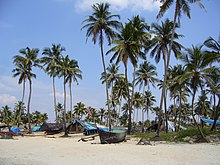
Equatorial forestcover in Goa stands at 1,500 km2(579 sq mi),[15]most of which is owned by the government. Government-owned forest is estimated at 1,300 km2(502 sq mi) while private is given as 200 km2(77 sq mi). Most of the forests in the state are located in the interior eastern regions of the state. TheWestern Ghats,which form most of eastern Goa, have been internationally recognised as one of the biodiversity hotspots of the world. In the February 1999 issue ofNational Geographic Magazine,Goa was compared with the Amazon and the Congo basins for its rich tropical biodiversity.[48]
Goa's wildlife sanctuaries boast of more than 1512 documented species of plants, over 275 species of birds, over 48 kinds of animals and over 60 genera of reptiles.[49]Nanda Lakeis the first and the only Ramsar wetland site in Goa.[50]
Goa is also known for its coconut cultivation. The coconut tree has been reclassified by the government as a palm (like grass), enabling farmers and real estate developers to clear land with fewer restrictions.[citation needed]
Rice is the main food crop, and pulses (legume),Ragi(Finger Millet), and other food crops are also grown. Main cash crops are arecanut, coconut, cashew nut, sugar cane, and fruits like banana, mango, and pineapple.[15]Goa's state animal is theGaur,the state bird is theFlame-throatedBulbul,and the state tree is theIndian Laurel.[citation needed]

The important forest products are bamboo canes,Marathabarks, chillar barks, and thebhirand.Coconut palm trees are common throughout Goa barring the elevated regions. A variety ofdeciduoustrees, such as teak, Sal tree, cashew, and mango trees are present. Fruits include jackfruit, mango, pineapple, and blackberry. Goa's forests are rich in medicinal plants.[citation needed]
Foxes, wild boar and migratory birds are found in the jungles of Goa. The avifauna (bird species) includes kingfisher,mynaand parrot. Numerous types of fish are also caught off the coast of Goa and in its rivers. Crab, lobster, shrimp, jellyfish, oysters, and catfish are the basis of the marine fishery. Goa also has a high snake population. Goa has many famous "National Parks", including the renownedSalim Ali Bird Sanctuaryon the island ofChorão.Other wildlife sanctuaries include theBondla Wildlife Sanctuary,Molem Wildlife Sanctuary,Cotigao Wildlife Sanctuary,Mhadei Wildlife Sanctuary,Netravali Wildlife Sanctuary,andMahaveer Wildlife Sanctuary.[citation needed]
Goa has more than 33% of its geographic area under government forests (1,224.38 km2or 472.74 sq mi) of which about 62% has been brought under Protected Areas (PA) of Wildlife Sanctuaries and National Park. Since there is a substantial area under private forests and a large tract under cashew, mango, coconut, etc. plantations, the total forest and tree cover constitutes 56.6% of the geographic area.[citation needed]
Economy
[edit]| Gross State Domestic Product (in millions of Rupees)[51] | |
| Year | GSDP |
|---|---|
| 1980 | 3,980 |
| 1985 | 6,550 |
| 1990 | 12,570 |
| 1995 | 33,190 |
| 2000 | 76,980 |
| 2010 | 150,000 |
Goa's state domestic product for 2017 is estimated at $11 billion at current prices. Goa is India's richest state with the highest GDP per capita—two and a half times that of the country—with one of its fastest growth rates: 8.23% (yearly average 1990–2000).[52]Tourism is Goa's primary industry: it gets 12%[53]of foreign tourist arrivals in India. Goa has two main tourist seasons: winter and summer. In winter, tourists from abroad (mainly Europe) come, and summer (which, in Goa, is the rainy season) sees tourists from across India. Goa'snet state domestic product(NSDP) was around US$7.24 billion in 2015–16.[54]
The land away from the coast is rich in minerals and ores, and mining forms the second largest industry. Iron, bauxite, manganese, clays, limestone, and silica are mined. TheMormugaoport handled 31.69 a million tonnes of cargo in 2007, which was 39% of India's total iron ore exports.Sesa Goa(now owned by Vedanta Resources) and Dempo are the lead miners. Rampant mining has been depleting the forest cover as well as posing a health hazard to the local population. Corporations are also mining illegally in some areas. During 2015–16, the total traffic handled by Mormugao port was recorded to be 20.78 million tonnes.[citation needed]
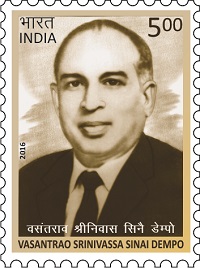
Agriculture, while of shrinking importance to the economy over the past four decades, offers part-time employment to a sizeable portion of the populace. Rice is the main agricultural crop, followed byareca,cashew,andcoconut.Fishing employs about 40,000 people, though recent official figures indicate a decline in the importance of this sector and also a fall in the catch, due perhaps, to traditional fishing giving way to large-scale mechanised trawling.[citation needed]
Medium-scale industries include the manufacturing of pesticides, fertilizers, tires, tubes, footwear, chemicals, pharmaceuticals, wheat products, steel rolling, fruits and fish canning, cashew nuts, textiles, brewery products.[citation needed]
Currently, there are 16 planned SEZs in Goa. The Goa government has recently decided to not allow any moreSpecial Economic Zones(SEZs) in Goa after strong opposition to them by political parties and the Goa Catholic Church.[55]
Goa is also notable for its low-priced beer, wine, and spirits prices due to its very low excise duty on alcohol. Another main source of cash inflow to the state is remittance, from many of its citizens who work abroad, to their families. It is said to have some of the largest bank savings in the country.[citation needed]
In 1976 Goa became the first state in India to legalise some types of gambling. This enabled the state to levy taxes on gambling, thereby strengthening the economy. There are several casinos available in Goa. In 2018-2019 tax revenue from casinos reached Rs 414 crore.[56]
Goa is the second state in India to achieve a 100 per cent automatic telephone system with a solid network of telephone exchanges. As of September 2017, Goa had a total installed power generation capacity of 547.88 MW. Goa is also one of the few states in India to achieve 100 per cent rural electrification.[57]
-
Commercial area inPanaji
Demographics
[edit]Population
[edit]| Year | Pop. | ±% p.a. |
|---|---|---|
| 1901 | 475,513 | — |
| 1911 | 486,752 | +0.23% |
| 1921 | 469,494 | −0.36% |
| 1931 | 505,281 | +0.74% |
| 1940 | 540,925 | +0.76% |
| 1950 | 547,448 | +0.12% |
| 1960 | 589,997 | +0.75% |
| 1971 | 795,120 | +2.75% |
| 1981 | 1,007,749 | +2.40% |
| 1991 | 1,169,793 | +1.50% |
| 2001 | 1,347,668 | +1.43% |
| 2011 | 1,458,545 | +0.79% |
| Source:[58] | ||
A native of Goa is called aGoan.Goa has a population of 1.459 million residents as of 2011,[59]making it the fourth least populated state of India afterSikkim,Mizoram,andArunachal Pradesh.Population density of Goa is 394 per km2which is higher than national average 382 per km2.Goa is the state with highest proportion of urban population with 62.17% of the population living in urban areas. Thesex ratiois 973 females to 1,000 males. The birth rate was 15.70 per 1,000 people in 2007. Scheduled Castes and Scheduled Tribes make up 1.74% and 10.23% of the population respectively. As of the 2011 census, over 76% of the population was born in Goa, while just over half of migrants to the state are from the neighbouring states of Karnataka and Maharashtra.[60]As per a 2021 report, over 50% of the permanent resident population is of non-Goan origin, outnumbering the native ethnic Goan population.[61]
Languages
[edit]The Official Language Act, 1987, of the erstwhile Union Territory ofGoa, Daman and DiumakesKonkaniin theDevanagariscript the sole official language of Goa, but provides thatMarathimay also be used "for all or any of the official purposes".Portuguesewas the sole official language duringPortuguese colonial rule.The government also has a policy of replying in Marathi to correspondence received in Marathi.[64]There have been demands for accordingKonkani in the Roman scriptofficial status in the state. There is widespread support for keeping Konkani as the sole official language of Goa.[65]
Konkani is spoken as a first language by about 66.11% of the people in the state, but almost all Goans can speak and understand Konkani. A large population of people can speak and understand English as well. Other linguistic groups in the state per the 2011 census are speakers ofMarathi(10.89%),Hindi(8.64%),Kannada(4.65%),Urdu(2.83%), andPortuguese(1%).[66]
Historically, Konkani was neither the official nor the administrative language of the many rulers of the State. Under theKadambas(c. 960–1310), the court language was Kannada. When under Muslim rule (1312–1370 and 1469–1510), the official and cultural language wasPersian.Various stones in theArchaeological Museum and Portrait Galleryfrom the period are inscribed in Kannada and Persian.[67]During the period in between the two periods of Muslim rule, theVijayanagara Empire,which had control of the state, mandated the use ofKannadaandTelugu.[67]
Religion
[edit]Religion in Goa (2011)[59]
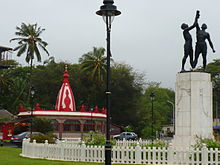
According to the 2011 census, in a population of 1,458,545 people, 66.1% wereHindu,25.1% wereChristian,8.3% wereMuslim,and 0.1% wereSikh.[59]
According to the 1909 statistics in the Catholic Encyclopedia, the total Catholic population in Portuguese controlled Goa was 293,628 out of a total population of 365,291 (80.33%).[68]Since the 20th century, the percentage ofGoan Catholicshas been facing continual decline caused by a combination of permanent emigration from Goa to cosmopolitan Indian cities (e.g.Mumbai,Pune,Bangalore) and foreign countries (e.g.Portugal,theUnited Kingdom)[69]with the mass immigration of non-Christians from the rest of India since the 20th century.[70]As of 2021, ethnicGoansrepresent less than 50% of the state's residents.[61]
The Catholics in Goa state andDaman and Diuunion territory are served by the MetropolitanRoman Catholic Archdiocese of Goa and Daman,theprimatial seeof India, in which the titularPatriarchate of the East Indiesis vested.[71]
Tourism
[edit]Tourism is generally focused on the coastal areas of Goa, with lower tourist activity inland. In 2010, there were more than 2 million tourists reported to have visited Goa, about 1.2 million of whom were from abroad.[72]As of 2013[update],Goa was a destination of choice for Indian and foreign tourists, particularly Britons and Russians, with limited means who wanted to vacation outside of their countries. The state was hopeful that changes could be made which would attract a more upscale demographic.[73]
Goa stands 6th in the Top 10 Nightlife cities in the world inNational Geographic Travel.[74]One of the biggest tourist attractions in Goa is water sports. Beaches like Baga and Calangute offer jet-skiing, parasailing, banana boat rides, water scooter rides, and more. Patnem beach inPalolemstood third inCNN Travel's Top 20 Beaches inAsia.[75]
Over 450 years of Portuguese rule and the influence of the Portuguese culture presents to visitors to Goa a cultural environment that is not found elsewhere in India. Goa is often described as a fusion between Eastern and Western culture with Portuguese culture having a dominant position in the state be it in its architectural, cultural or social settings. The state of Goa is famous for its excellent beaches, churches, and temples.[76]
Historic sites and neighbourhoods
[edit]
Goa has oneWorld Heritage Site:theBom Jesus Basilica[77]withchurches and convents of Old Goa.The basilica holds the mortal remains ofFrancis Xavier,regarded by many Catholics as thepatron saintof Goa (the patron of theArchdiocese of Goais actually SaintJoseph Vaz). These are both Portuguese-era monuments and reflect a strong European character. The relics are taken down for veneration and for public viewing, per the prerogative of the Church in Goa, not every ten or twelve years as popularly thought and propagated. The last exposition was held in 2014.[78]

| Year | Total Arrivals | % Change |
|---|---|---|
| 1985 | 775,212 | |
| 1990 | 881,323 | |
| 1995 | 1,107,705 | |
| 2000 | 1,268,513 | |
| 2005 | 2,302,146 | |
| 2010 | 2,644,805 | |
| 2015 | 5,297,902 |
TheVelhas Conquistasregions are known for Goa-Portuguese style architecture. There are many forts in Goa such asTiracol,Chapora,Corjuem,Aguada,Reis Magos,Nanus,Mormugao,Fort Gaspar Dias andCabo de Rama.[80]
In many parts of Goa, mansions constructed in the Indo-Portuguese style architecture still stand, though, in some villages, most of them are in a dilapidated condition.Fontainhasin Panaji has been declared a cultural quarter, showcasing the life, architecture and culture of Goa. Influences from the Portuguese era are visible in some of Goa's temples, notably theShanta Durga Temple,theMangueshi Temple,theShri Damodar Templeand theMahalasaTemple. After 1961, many of these were demolished and reconstructed in the indigenous Indian style.[81]
Museums and science centre
[edit]Goa has three important museums: theGoa State Museum,theNaval Aviation Museumand theNational Institute of Oceanography.The aviation museum is one of three in India (the others are inDelhiandBangalore). TheGoa Science Centreis in Miramar, Panaji.[82]TheNational Institute of Oceanography, India(NIO) is in Dona Paula.[83]Museum of Goais a privately owned contemporary art gallery in Pilerne Industrial Estate, nearCalangute.[84]
Beaches
[edit]Most of the beauty of Goa is present on the beaches. The coastline of about 103 kilometres (64 mi) has some of the most attractive beaches flanked by the Arabian Sea. The beaches of Goa are counted among the most beautiful in the world.[85][non-primary source needed]Some of the beaches includeAnjuna Beach,Baga Beach,Bambolim Beach,Betul Beach,Calangute Beach,Candolim Beach,Cavelossim Beach,Colva Beach,Butterfly Beach,Majorda BeachandMiramar Beach.[citation needed]
Culture
[edit]
Having been aPortuguese territoryfor over 450 years, Goan culture is an amalgamation of bothEasternandWesternstyles, with the latter having a more dominant role. The tableau of Goa showcases religious harmony by focusing on the Deepastambha, the Cross, and Ghode Modni followed by a chariot. European royal attire of kings is as much part of Goa's cultural heritage as are regional dances performed depicting a unique blend of different religions and cultures of this State. Prominent local festivals areChristmas,Easter,Carnival,Diwali,Shigmo,Chavoth,Samvatsar Padvo,Dasaraetc. The Goan Carnival and Christmas-new year celebrations attract many tourists.[citation needed]
TheGomant Vibhushan Award,the highest civilian honour of the state of Goa, is given annually by theGovernment of Goasince 2010.[86][87]
Dance and music
[edit]Traditional Goan art forms areDekhnni,Fugdi,Corridinho,Mando,DulpodandFado.[88]
Goan Hindus are very fond ofNatak,BhajanandKirtan.[citation needed]Many famousIndian classicalsingers hail from Goa, includingMogubai Kurdikar,Kishori Amonkar,Kesarbai Kerkar,Jitendra Abhishekiand Pandit Prabhakar Karekar.[citation needed]
Theatre
[edit]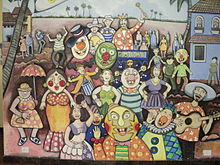
Natak,Tiatr(most popular) and Jagor are the chief forms of Goa's traditional performance arts. Other forms are Ranmale, Dashavatari, Kalo, Goulankala, Lalit, Kala and Rathkala.[citation needed]Stories from theRamayanaand theMahabharataalong with more modern social subjects are narrated with song and dance.[89][90]
"Jagor", the traditional folk dance-drama, is performed by the Hindu Kunbi and Christian Gauda community of Goa, to seek the Divine Grace for protection and prosperity of the crop. The literal meaning of Jagor is "jagran" or wakeful nights. The strong belief is that the night-long performance awakens the deities once a year and they continue to remain awake throughout the year guarding the village.[citation needed]
Perni Jagor is the ancient mask dance – drama of Goa, performed by Perni families, using well crafted and painted wooden masks, depicting various animals, birds, super natural power, deities, demons, and social characters.[citation needed]
Gauda Jagor is an impression of social life, that displays all the existing moods and modes of human characters. It is predominantly based on three main characters, Gharasher, Nikhandar, and Parpati wearing shining dresses and headgears. The performance is accompanied by vibrant tunes of Goan folk instruments like Nagara/Dobe, Ghumat, Madale, and Kansale.[citation needed]
In some places, Jagor performances are held with the participation of both Hindus and the Christian community, whereby, characters are played by Hindus and musical support is provided by Christian artistes.[91]
Tiatr (Teatro)and its artists play a major role in keeping the Konkani language and music alive. Tiatrs are conducted solely in the Roman script of Konkani as it is primarily a Christian community-based act. They are played in scenes with music at regular intervals, the scenes are portrayals of daily life and are known to depict social and cultural scenarios. Tiatrs are regularly held especially on weekends mainly at Kala Academy, Panaji, Pai Tiatrist Hall at Ravindra Bhavan, Margao and most recent shows have also started at the new Ravindra Bhavan, Baina, Vasco. Western Musical Instruments such as Drums, Bass, Keyboards, and Trumpets. are part of the show and most of them are played acoustically.[citation needed]It is one of Goa's few art forms that is renowned across the world with performances popular among Goans in the Middle-East, Americas and Europe.[citation needed]
Konkani cinema
[edit]
Konkani cinemais anIndian filmindustry, wherefilmsare made in theKonkani language,which is spoken mainly in theIndianstates of Goa,MaharashtraandKarnatakaand to a smaller extent inKerala.Konkani films have been produced in Goa,Karnataka,MaharashtraandKerala.[92]
The first full-length Konkani film wasMogacho Anvddo,released on 24 April 1950, and was produced and directed by A. L.Jerry Braganza, a native ofMapusa,under the banner of ETICA Pictures.[93][94]Hence, 24 April is celebrated as Konkani Film Day.[95]Since 2004, starting from the 35th edition, theInternational Film Festival of Indiamoved its permanent venue to Goa, it is annually held in the months of November and December.[96]Konkani filmPaltadcho manishas been included in the world's best films of 2009 list.[97]
Konkani films are eligible for theNational Film Award for Best Feature Film in Konkani.The most commercially successful Konkani film, as of June 2011[update],isO Mariadirected by Rajendra Talak.[98]In 2012, the whole new change was adopted in Konkani Cinema by introducing Digital Theatrical FilmThe Victimdirected by Milroy Goes.[99]Some old Konkani films areSukhachem Sopon,Amchem Noxib,Nirmonn,Mhoji Ghorkarn,Kortubancho Sonvsar,Jivit Amchem Oxem,Mog ani Moipas,Bhuierantlo Munis,Suzanne,Boglantt,PadriandBhogsonne.Ujwaduis a 2011 Konkani film directed by Kasargod Chinna and produced by KJ Dhananjaya and Anuradha Padiyar.[citation needed]
Food
[edit]-
Goan prawn curry, a popular dish throughout the state
-
Porkvindaloois a popular Goan curry dish in the state and around the world.
-
Chamuças,Goan samosas
-
Traditional Goan fish curry
Rice with fishcurry(xit koddiinKonkani) is the staple diet in Goa.Goan cuisineis famous for its rich variety of fish dishes cooked with elaborate recipes.Coconutandcoconut oilare widely used in Goan cooking along withchili peppers,spices,andvinegar,used in the Catholic cuisine, giving the food a unique flavor. Goan cuisine is heavily influenced byPortuguese cuisine.[citation needed]
Goan food may be divided into Goan Catholic and Goan Hindu cuisine with each showing very distinct tastes, characteristics, and cooking styles.Porkdishes such asVindalho,Xacuti,chouriço,andSorpotelare cooked for major occasions among theGoan Catholics.A mixed vegetable stew, known asKhatkhate,is a very popular dish during the celebrations of festivals, Hindu and Christian alike. Khatkhate contains at least five vegetables, fresh coconut, and special Goan spices that add to the aroma.[citation needed]Sannas,Hitt,are local rice cakes andPolle,Amboli,andKailoleoare rice pancakes; all are native to Goa. A richegg-based, multi-layered baked sweet known asbebincais traditional at Christmas.[citation needed]
The most popular alcoholic beverage in Goa isfeni.Cashew feni is made from the double distillation of the fermented fruit juice of the cashew tree, while coconut feni is made from the double distillation of the fermented sap of toddy palms. Urrak is another local liquor prepared from the single distillation of the fermented cashew fruit juice. In fact the bar culture is one of the unique aspects of the Goan villages where a local bar serves as a meeting point for villagers to unwind.[100]Goa also has a rich wine culture due to Portuguese rule.[101][102]
Architecture
[edit]The architecture of Goa is a combination of native Goan,OttomanandPortuguesestyles. Since the Portuguese ruled and governed for four centuries, many churches and houses bear a striking element of the Portuguese style of architecture. Goan Hindu houses do not show any Portuguese influence, though the modern temple architecture is an amalgam of original Goan temple style withDravidian,Hemadpanti,Islamic, and Portuguese architecture.[103]The original Goan temple architecture fell into disuse as the temples were demolished by the Portuguese and theSthapatiknown asThavayiin Konkani were converted to Christianity though the wooden work and theKavimurals can still be seen.[104]
Notable people
[edit]Famous people from Goa encompass various categories, such as architects, artists, engineers, governors, indologists & archaeologists, lawyers & judges, military personnel, models and pageant winners, politicians, individuals in the field of education, scientists and researchers, athletes, writers, editors, and journalists, as well as activists.
Media and communication
[edit]Goa is served by almost alltelevision channelsavailable in India. Channels are received through cable in most parts of Goa. In the interior regions, channels are received viasatellite dishes.Doordarshan,the national television broadcaster, has two free terrestrial channels on air.[105]
DTH (Direct To Home) TV services are available fromDish TV,Videocon D2H,Tata SkyandDD Direct Plus.TheAll India Radiois the onlyradio channelin the state that broadcasts on bothFMandAMbands. Two AM channels are broadcast, the primary channel at 1287 kHz and the Vividh Bharati channel at 1539 kHz. AIR's FM channel is called FM Rainbow and is broadcast at 105.4 MHz. A number of private FM radio channels are available,Big FMat 92.7 andRadio Indigoat 91.9 MHz. There is also an educational radio channel,Gyan Vani,run byIGNOUbroadcast from Panaji at 107.8 MHz. In 2006, St Xavier's College, Mapusa, became the first college in the state to launch a campus community radio station "Voice of Xavier's".[106]
Major cellular service operators includeBharti Airtel,Vodafone Essar,Idea Cellular(merged with Vodafone in 2018),Telenor,Reliance Infocomm,Tata DoCoMo,BSNLCellOneandJio.[citation needed]
Local publications include theEnglish languageO Heraldo(Goa's oldest, once a Portuguese language paper),The Gomantak TimesandThe Navhind Times.In addition to these,The Times of IndiaandThe Indian Expressare also received from Mumbai and Bangalore in the urban areas.The Times of Indiahas recently started publication from Goa itself, serving the local population news directly from the state capital. Among the list of officially accredited newspapers areO Heraldo,The Navhind TimesandThe Gomantak Timesin English;Bhaangar Bhuinin Konkani (Devanagari script); andTarun Bharat,Gomantak,Navprabha,Goa Times,Sanatan Prabhat,GovadootandLokmat(all in Marathi). All are dailies. Other publications in the state includePlanet Goa(English, monthly),Goa Today(English, monthly),Goan Observer(English, weekly),Vauraddeancho Ixtt(Roman-script Konkani,weekly)Goa Messenger,Vasco Watch,Gulab(Konkani, monthly),Bimb(Devanagari-script Konkani).[107]
Oneelectronic mailing listthat is based in Goa isGoanet.[108][109][better source needed]
Sports
[edit]
Normally other states are fond of cricket butassociation footballis the most popular sport in Goa and is embedded in Goan culture as a result of the Portuguese influence.[110]Its origins in the state are traced back to 1883 when the visiting Irish priest Fr. William Robert Lyons established the sport as part of a "Christian education".[110][111]On 22 December 1959, theAssociação de Futebol de Goawas formed, which continues to administer the game in the state under the new nameGoa Football Association.[110]Goa, along withWest BengalandKerala[110]is the locus of football in India and is home to many football clubs in the nationalI-League.The state's football powerhouses includeSalgaocar,Dempo,Churchill Brothers,Vasco,Sporting Clube de GoaandFC Goa.The firstUnity World Cupwas held in Goa in 2014. The state's main football stadium,Fatorda Stadium,is located atMargaoand also hosts cricket matches.[112]The state hosted few matches of the2017 FIFA U-17 World Cupand several matches of the2022 FIFA U-17 Women's World Cupin Fatorda Stadium.[113][114]
A number of Goans have represented India in football and six of them, namelySamir Naik,Climax Lawrence,Brahmanand Sankhwalkar,Bruno Coutinho,Mauricio Afonsoand Roberto Fernandes have all captained the national team. Goa has its ownstate football teamand league, theGoa Professional League.It is probably the only state in India where cricket is not considered the most important of all sports. Goan's are avid football fans, particularly of the football teams from Portugal (Benfica, Sporting), and Brazil especially during major football events such as the European Cup and the World Cup championships. The Portuguese footballerRonaldoand BrazilianNeymar,are revered superstar football players in Goa.[citation needed]
Goa also has its owncricket team.Dilip SardesaiandShikha Pandeyremain the only Goans to date to play international cricket forIndia.[115]Another Goan cricketer,Suyash Prabhudessaiwas selected by theRoyal Challengers Bangalorefor a base price of₹20 lakhinIPL2021 and for₹30 lakhin IPL 2022.[116][117]
India (Goa) is a member of theLusofonia gameswhich are hosted every four years in one of the Portuguese CPLP member countries, with 733 athletes from 11 countries. Most of the countries competing are countries that are members of the CPLP (Community of Portuguese Language Countries), but some are countries with significant Portuguese communities or have a history with Portugal. This event is similar in concept to the Commonwealth Games (for members of the Commonwealth of Nations) and the Jeux de la Francophonie (for the Francophone community).[citation needed]
Education
[edit]-
Carmel College for Women, established more than 50 years ago to address the education gender gap, is affiliated to Goa University.
-
Goa Medical College,previously calledEscola Médico–Cirúrgica de Goa
Goa had India's earliest educational institutions built with European support. The Portuguese set up seminaries for religious education and parish schools for elementary education. Foundedc. 1542by Saint Francis Xavier,Saint Paul's College, Goawas a Jesuit school in Old Goa, which later became a college. St Paul's was once the main Jesuit institution in Asia. It housed the first printing press in India and published the first books in 1556.[118][119][120]
Medical education began in 1801 with the offering of regular medical courses at the Royal and Military Hospital in the old City of Goa. Built-in 1842 as the Escola Médico-Cirúrgica de (Nova) Goa (Medical-Surgical School of Goa),Goa Medical Collegeis one of Asia's oldest medical colleges and has one of the oldest medical libraries (since 1845).[121]It houses the largest hospital in Goa and continues to provide medical training to this day.[citation needed]
According to the 2011 census, Goa has aliteracy rateof 87%, with 90% of males and 84% of females being literate.[122]Each taluka is made up of villages, each having a school run by the government. Private schools are preferred over government-run schools. All schools come under theGoa Board of Secondary and Higher Secondary Education,whose syllabus is prescribed by the state education department. There are also a few schools that subscribe to the all-IndiaICSEsyllabus or theNIOSsyllabus. Most students in Goa complete their high school with English as the medium of instruction. Most primary schools, however, use Konkani and Marathi (in private, but government-aided schools). As is the case in most of India, enrolment for vernacular media has seen a fall in numbers in favour of English medium education. Per a report published inThe Times of India,84% of Goan primary schools were run without an administrative head.[123]
Some notable schools in Goa includeSharada MandirSchool inMiramar,Loyola High Schoolin Margao andThe King's SchoolinSão José de Areal.After ten years of schooling, students join a Higher Secondary school, which offers courses in popular streams such asScience,Arts,Law,andCommerce.A student may also opt for a course in vocational studies. Additionally, they may join three-yeardiplomacourses. Two years of college is followed by aprofessional degreeprogramme.Goa University,the soleuniversityin Goa, is located inTaleigãoand most Goan colleges are affiliated with it.[citation needed]
There are sixengineeringcolleges in the state.Goa Engineering CollegeandNational Institute of Technology Goaare government-funded colleges whereas the private engineering colleges include Don Bosco College of Engineering at Fatorda, Shree Rayeshwar Institute of Engineering and Information Technology at Shiroda, Agnel Institute of Technology, and Design (AITD), Assagao, Bardez andPadre Conceicao College of Engineeringat Verna. In 2004,BITS Pilanione of the premier institutes in India, inaugurated its second campus, theBITS Pilani Goa Campus,at Zuarinagar nearDabolim.The Indian Institute of Technology Goa (IIT Goa) began functioning from its temporary campus, located in Goa Engineering College since 2016. The site for permanent campus was finalised in Cotarli,Sanguem.[124]
There are colleges offeringpharmacy,architectureanddentistryalong with numerous private colleges offeringlaw,arts,commerceandscience.There are also two National Oceanographic Science related centres: theNational Centre for Antarctic and Ocean Researchin Vasco da Gama and theNational Institute of OceanographyinDona Paula.[citation needed]Goa Institute of Managementlocated at Sanquelim, near Panaji is one of India's premier business schools.[citation needed]In addition to the engineering colleges, there are government polytechnic institutions inPanaji,BicholimandCurchorem,and aided institutions like Father Agnel Polytechnic in Verna and the Institute of Shipbuilding Technology in Vasco da Gama which impart technical and vocational training.[125]
Other colleges in Goa include Shri Damodar College of Commerce and Economics, V.V.M's R.M. Salgaocar Higher Secondary School inMargao,G.V.M's S.N.J.A higher secondary school, Don Bosco College, D.M.'s College of Arts, Science and Commerce, St Xavier's College, Carmel College,The Parvatibai Chowgule College,Dhempe College, Damodar College, M. E. S. College of Arts & Commerce, S. S. Samiti's Higher Secondary School of Science and Rosary College of Commerce & Arts. As the result of renewed interest in the Portuguese language and culture, Portuguese at all levels of instruction is offered in many schools in Goa, largely private ones. In some cases, Goan students do student exchange programs in Portugal.[citation needed]
Transportation
[edit]Air
[edit]
Goa is served by two international Airports.Goa International Airport,is acivil enclaveatINS Hansa,a Naval airfield[126]located atDabolim,nearVasco da Gamawhile theManohar International Airportis located in the North atMopa.[127] Within five months of its inception, Mopa airport began handling 30 per cent of all air traffic of Goa.[128] The airports cater to scheduled domestic and international air services, with the new airport having started international operations from March 2023.[129] Goa has scheduled international connections toDoha,Dubai,Muscat,SharjahandKuwaitin theMiddle Eastby airlines likeAir Arabia,Air India,GoAir,IndiGo,Oman Air,SpiceJetandQatar Airways.
Road
[edit]
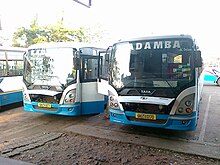
Goa'spublic transportlargely consists of privately operated buses linking the major towns to rural areas. Government-run buses, maintained by theKadamba Transport Corporation,link major routes (like the Panaji–Margao route) and some remote parts of the state. The Corporation owns 15 bus stands, 4 depots and one Central workshop at Porvorim and a Head Office at Porvorim.[130]In large towns such as Panaji and Margao, intra-city buses operate. However, public transport in Goa is less developed, and residents depend heavily on their own transportation, usually motorised two-wheelers and small family cars.[citation needed]

Goa has fourNational Highwayspassing through it. NH-66 (exNH-17) runs along India's west coast and links Goa toMumbaiin the north andMangaloreto the south.NH-4Arunning across the state connects the capital Panaji toBelgaumin east, linking Goa to cities in theDeccan.The NH-366 (exNH-17A) connects NH-66 toMormugaoPort from Cortalim. The new NH-566 (ex NH-17B) is a four-lane highway connecting Mormugao Port to NH-66 at Verna viaDabolim Airport,primarily built to ease pressure on the NH-366 for traffic to Dabolim Airport and Vasco da Gama. NH-768 (ex NH-4A) links Panaji and Ponda to Belgaum and NH-4. Goa has a total of 224 km (139 mi) of national highways, 232 km (144 mi) of state highway and 815 kilometres (506 miles) of district highway. National Highways in Goa are among the narrowest in the country and will remain so for the foreseeable future, as the state government has received an exemption that allows narrow national highways. In Kerala, highways are 45 metres (148 feet) wide. In other states National Highways are grade separated highways 60 metres (200 feet) wide with a minimum of four lanes, as well as 6 or 8 lane access-controlled expressways.[131][132]
Hired forms of transport include unmetered taxis and, in urban areas,auto rickshaws.Another form of transportation in Goa is themotorcycle taxi,operated by drivers who are locally called "pilots". These vehicles transport a singlepillionrider, at fares that are usually negotiated. Other than buses, "pilots" tend to be the cheapest mode of transport.[133]River crossings in Goa are serviced by flat-bottomedferryboats, operated by the river navigation department.[citation needed]
Goa will get two new expressways in the coming years, which will connect the state and will enhance connectivity and commute with the rest of the country. They are as follows:
- Nagpur–Goa Expressway:Proposed, to be completed by 2028/29.[134][135]
- Konkan Expressway: Proposed.[136]
Rail
[edit]
Goa has tworail lines– one run by the South Western Railway and the other by theKonkan Railway.The line run by theSouth Western Railwaywas built during the colonial era linking the port town ofVasco da Gama, GoawithBelgaum,Hubli,KarnatakaviaMargao.The Konkan Railway line, which was built during the 1990s, runs parallel to the coast connecting major cities on the western coast.[citation needed]
Metro
[edit]In 2018, a metro rail was planned by theNITI Aayog,linking the capital city ofPanaji.In the future, it would be extended from South Goa till the coastal city ofKarwarinKarnataka,close to the Kanataka-Goa border.[137]
Sea
[edit]TheMormugao Port Trustnear the city of Vasco handles mineral ore, petroleum, coal, and international containers. Much of the shipments consist of minerals and ores from Goa's hinterland. Panaji, which is on the banks of the Mandovi, has a minor port, which used to handle passengerssteamersbetween Goa and Mumbai till the late 1980s. There was also a short-lived catamaran service linking Mumbai and Panaji operated by Damania Shipping in the 1990s.[citation needed]
Organised crime
[edit]Sister states
[edit]See also
[edit]References
[edit]- ^Nadaf, F M (April 2019)."Geographical Diagnosis of Goa's Tourism beyond Sun and Sand".Online International Interdisciplinary Research Journal.
- ^"Indian Districts by Population, Sex Ratio, Literacy 2011 Census".Archivedfrom the original on 11 June 2011.Retrieved26 August2018.
- ^"The Goa, Daman and Diu Official Language Act, 1987"(PDF).indiacode.nic.in.Retrieved12 November2022.
- ^"Languages of Goa".Department of Information and Publicity.Archived from the original on 31 December 2023.
{{cite web}}:CS1 maint: unfit URL (link) - ^"The Goa, Daman and Diu Official Language Act, 1987 (Act No. 5 of 1987) [14-4-1987]"(PDF).Secretary to the Government of Goa, Daman and Diu.Retrieved6 July2024.
- ^ab"MOSPI State Domestic Product, Ministry of Statistics and Programme Implementation, Government of India".15 March 2021.Retrieved28 March2021.
- ^ab"HDI - Area Database - Global Data Lab".hdi.globaldatalab.org.15 June 2021.Retrieved2 October2022.
- ^"Census 2011 (Final Data) – Demographic details, Literate Population (Total, Rural & Urban)"(PDF).planningcommission.gov.in.Planning Commission, Government of India. Archived fromthe original(PDF)on 27 January 2018.Retrieved3 October2018.
- ^"Goa - state, India".Britannica.Retrieved29 November2020.
- ^Henn, Alexander (2014).Hindu-Catholic Encounters in Goa: Religion, Colonialism, and Modernity.Bloomington, Ind.: Indiana University Press. p. 1.ISBN9780253013002.OCLC890531126.Archivedfrom the original on 15 February 2019.Retrieved15 February2019.
- ^Kincaid, John;Aroney, Nicholas (2017). "The Supreme Court of India".Courts in federal countries: federalists or unitarists?.Toronto: University of Toronto Press. p. 225.ISBN9781487514662.OCLC982378193.
- ^abIndia Finance Commission (2005).Reports of the finance commissions of India: First Finance Commission to the Twelfth Finance Commission: the complete report.New Delhi: Academic Foundation. p. 268.ISBN978-81-7188-474-2.
- ^"Liberation of Goa".Government Polytechnic, Panaji. Archived fromthe originalon 28 September 2007.Retrieved17 July2007.
- ^Pillarisetti, Jagan."The Liberation of Goa: an Overview".The Liberation of Goa:1961.bharat-rakshak. Archived fromthe originalon 9 August 2007.Retrieved17 July2007.
- ^abc"Goa".National Informatics Centre(NIC). Archived fromthe originalon 18 December 2008.Retrieved4 January2009.
- ^Sakshena, R.N. (June 2003).Goa: Into the Mainstream.Abhinav Publications. p. 5.ISBN9788170170051.Archivedfrom the original on 21 October 2016.Retrieved9 October2016.
- ^Purātattva, Issue 36.Indian Archaeological Society. 2006. p. 254.
- ^Petraglia, M. D.; Allchin, Bridget (2007).The evolution and history of human populations in South Asia: inter-disciplinary studies in archaeology, biological anthropology, linguistics and genetics.Dordrecht, the Netherlands: Springer. p. 85.ISBN9781402055621.OCLC187951478.
- ^Chakravarty, Kalyan Kumar; Bednarik, Robert G.; Indirā Gāndhī Rāshṭrīya Mānava Saṅgrahālaya (1997).Indian rock art and its global context(1st ed.). Delhi: Motilal Banarsidass Publishers. p. 34.ISBN9788120814646.OCLC38936967.
- ^Chakravarty, Kalyan Kumar; Bednarik, Robert G.; Indirā Gāndhī Rāshṭrīya Mānava Saṅgrahālaya (1997).Indian rock art and its global context(1st ed.). Delhi: Motilal Banarsidass Publishers. p. 70.ISBN9788120814646.OCLC38936967.
- ^C. R. Srinivasan; K. V. Ramesh; S. Subramonia Iyer (2004).Śrī puṣpāñjali: Recent Researches in Prehistory, Protohistory, Art, Architecture, Numismatics, Iconography, and Epigraphy: Dr. C.R. Srinivasan commemoration volume, Volume 1.Bharatiya Kala Prakashan. pp. 469 pages (see page4).ISBN9788180900563.
- ^Sakhardande, Prajal."7th National Conference on Marine Archaeology of Indian Ocean Countries: Session V".Heritage and history of Goa.NIO Goa. Archived fromthe originalon 24 July 2011.Retrieved30 March2011.
- ^Dhume, Anant Ramkrishna (1986).The cultural history of Goa from 10000 BC – 1352 AD.Ramesh Anant S. Dhume. pp. 355 pages (see pages 100–150).
- ^de Souza 1990,p.9
- ^de Souza 1990,p.10
- ^de Souza 1990,p.11
- ^Dobbie, Aline (2006).India: The Elephant's Blessing.Melrose Press. p. 220.
- ^Shastri, B. S. (1978)."Some Aspects of the First Conquest of Goa by the Portuguese".Proceedings of the Indian History Congress.39:385–392.ISSN2249-1937.JSTOR44139374.
- ^Roger Crowley(1 December 2015).Conquerors: How Portugal Forged the First Global Empire.Random House. pp. 262–264.ISBN978-0-571-29090-1.
- ^Anant Kakba Priolkar (1961).The Goa Inquisition: Being a Quatercentenary Commemoration Study of the Inquisition in India.Bombay University Press. p. 3.
- ^"The day India freed Goa".19 December 2017.Archivedfrom the original on 10 September 2019.Retrieved1 September2019.
- ^"What is Goa's 'Opinion Poll Day'?".Indian Express.Retrieved30 April2021.
- ^Faleiro, Valmiki."What a Monumental Shame!".The Goan Forum. Archived fromthe originalon 3 March 2007.Retrieved16 May2009.
- ^Prabhudesai, Sandesh."The Historic Opinion Poll".p. 1. Archived fromthe originalon 20 July 2008.Retrieved12 May2009.
- ^Poddar, Prem (2 July 2008).Historical Companion to Postcolonial Literatures - Continental Europe and its Empires.Edinburgh University Press.ISBN9780748630271.
- ^abcdeHiremath, K. G. (2003).Recent advances in environmental science.Discovery Pub. House. p. 401.ISBN9788171416790.OCLC56390521.
- ^"Weather Information for Goa".Archivedfrom the original on 2 July 2012.Retrieved24 July2012.
- ^"Climatological Information for Goa, India".Hong Kong Observatory. 15 August 2011. Archived fromthe originalon 20 January 2012.Retrieved16 December2011.
- ^"Directorate of Planning, Statistics & Evaluation"(PDF).Archived(PDF)from the original on 4 April 2018.
- ^Rubinoff, Arthur G. (1998).The construction of a political community: integration and identity in Goa.Sage Publications. p. 18.OCLC38918113.
- ^Rubinoff, Arthur G. (1998).The construction of a political community: integration and identity in Goa.Sage Publications. p. 19.OCLC38918113.
- ^Odds stacked against ParrikarArchived13 March 2007 at theWayback Machine,Anil Sastry,The Hindu,31 January 2005, verified 2 April 2005
- ^Banerjee, Sanjay (6 June 2007)."Congress set to rule Goa again".The Times of India.Times Internet Limited.Archivedfrom the original on 14 January 2009.Retrieved5 August2007.
- ^"North Goa District website".northgoa.nic.in.Archivedfrom the original on 19 December 2011.Retrieved16 December2011.
- ^"Congress Asks Why Is BJP Invited To Form Government in Goa".ndtv.Archivedfrom the original on 28 March 2017.Retrieved27 March2017.
- ^"Supreme Court to hear Congress plea against Goa governor's invitation to BJP".The Times of India.14 March 2017.Archivedfrom the original on 18 March 2017.Retrieved27 March2017.
- ^"Goa's BJP-led government wins floor test with support from 22 legislators".The Times of India.16 March 2017.Archivedfrom the original on 19 March 2017.Retrieved27 March2017.
- ^Siqueira, Evelyn (21 March 2022)."International Day of Forests 2022: Can you guess the 4 categories of forests in Goa?".Gomantak Times.Retrieved11 December2022.
- ^"Wildlife Sanctuaries in Goa".Archived fromthe originalon 20 July 2008.Retrieved18 July2008.
- ^"Nanda lake in Curchorem is Goa's first Ramsar site".Retrieved6 September2022.
- ^"Ministry of Statistics and Programme Implementation".Archived fromthe originalon 13 April 2006.Retrieved7 September2006.
- ^Mohan, Vibhor (16 September 2008)."Chandigarh's per capita income is highest in India".The Times of India.Archivedfrom the original on 19 July 2012.Retrieved16 December2011.
- ^Economy of GoaArchived29 March 2005 at theWayback Machine,fromgoenkarArchived2 April 2005 at theWayback Machineverified 2 April 2005.
- ^"About Goa: Tourism, Industries, Economy, Growth & Geography Information".ibef.org.Archivedfrom the original on 29 November 2016.Retrieved6 February2018.
- ^"Goa not to have any more SEZs".The Times of India.13 November 2007.Archivedfrom the original on 11 October 2008.Retrieved13 November2007.
- ^"Overview of Goa's Casino Communities".Env Media.17 July 2021.Retrieved30 May2022.
- ^"Goa Budget 2017"(PDF).Archived(PDF)from the original on 6 February 2018.
- ^"Table A-2 Decadal Variation in Population since 1901: Goa"(PDF).censusindia.gov.in.Registrar General and Census Commissioner of India.
- ^abc"India's religions by numbers".The Hindu(published 26 August 2015). 29 March 2016.Archivedfrom the original on 10 January 2016.Retrieved6 September2017.
- ^"Table D-01 Population classified by place of birth and sex: Goa".censusindia.gov.in.Registrar General and Census Commissioner of India.
- ^abMenezes, Vivek (15 May 2021)."Who belongs to Goa? This question resurfaces as the State battles the raging pandemic".The Hindu.Archived fromthe originalon 2 June 2021.Retrieved30 July2023.
Goans today represent less than 50% of the permanent population, and the pandemic has greatly accelerated this imbalance
- ^"C-16 Population By Mother Tongue - Goa".census.gov.in.Retrieved4 January2021.
- ^"Language – India, States and Union Territories"(PDF).Census of India 2011.Office of the Registrar General. pp. 13–14.Archived(PDF)from the original on 14 November 2018.Retrieved1 December2018.
- ^"42nd report: July 2003 – June 2004".Commissioner o fLinguistic Minorities. p. para 11.3. Archived fromthe originalon 8 October 2007.Retrieved6 June2007.
- ^"Solving the Language Imbroglio".Navhind Times.Archivedfrom the original on 7 September 2012.Retrieved15 October2008.
- ^"Census of India – DISTRIBUTION OF 10,000 PERSONS BY LANGUAGE".censusindia.gov.in.Archivedfrom the original on 11 October 2012.Retrieved17 March2012.
- ^abThomaz, Luís Filipe F. R. (1 October 2016)."The Socio-Linguistic Paradox of Goa".Human and Social Studies.5(3): 15–38.doi:10.1515/hssr-2016-0021.ISSN2285-5920.
- ^Ernest Hull (1909). "Archdiocese of Goa".Catholic Encyclopedia, Vol. 6.New York: Robert Appleton Company.
- ^Saldhana, Arun (2007).Psychedelic White: Goa Trance and the Viscosity of Race.University of Minnesota Press.ISBN978-0-8166-4994-5.
- ^Rajesh Ghadge (2015).The story of Goan Migration.
- ^"Archdiocese of Goa e Damão".Catholic-Hierarchy.org.2014.Archivedfrom the original on 18 May 2008.Retrieved31 July2008.
- ^"Tourist Arrivals (Year Wise)".Department of Tourism, Government of Goa website.Archived fromthe originalon 27 August 2010.Retrieved3 August2010.
- ^Gethin Chamberlain (31 August 2013)."Why Goa is looking to go upmarket – and banish Brits and backpackers: As visitor numbers dip, the Indian state wants to rid itself of budget tourists – but its rubbish mountains and beach gangs are putting off the rich".The Observer, The Guardian.Archivedfrom the original on 1 September 2013.Retrieved31 August2013.
- ^National Geographic Society (22 January 2015)."Top 10 Nightlife Cities – National Geographic Travel".National Geographic.Archived fromthe originalon 12 August 2016.Retrieved12 February2015.
- ^"20 idyllic beach getaways".CNN. 12 July 2017.Archivedfrom the original on 22 March 2018.Retrieved21 March2018.
- ^"5 most popular beaches in goa | TravelFiver".Archived fromthe originalon 6 April 2018.Retrieved6 April2018.
- ^"Basilica of Bom Jesus, Old Goa | Goa Jesuits".goajesuits.in. Archived fromthe originalon 15 June 2014.Retrieved18 July2010.
- ^"Pilgrims flock to Goa to see Saint Francis Xavier remains".BBC News.22 November 2014.Archivedfrom the original on 24 November 2014.Retrieved22 November2014.
- ^"Department of Tourism, Government of Goa, India - Tourist Arrivals (Year Wise)".goatourism.gov.in.Archived fromthe originalon 10 February 2018.Retrieved30 January2018.
- ^"Monuments & Structure of Goa – Department of Information and Publicity".Retrieved11 December2022.
- ^"Monuments & Structure of Goa".Retrieved11 December2022.
- ^"Goa Science Centre-Panjim".Archived fromthe originalon 3 December 2009.Retrieved3 August2010.,Nehru Science Centre website. Retrieved 4 August 2010.
- ^NIO websiteArchived19 August 2010 at theWayback Machine.Retrieved 4 August 2010.
- ^ Ray, Kunal (15 October 2015)."Artist Subodh Kerkar's Museum of Goa aims to provide a cultural experience for the Goans".The Hindu.Retrieved7 January2016.
- ^"Beaches | Government of Goa".Government of Goa | Official Portal.Retrieved11 December2022.
- ^"R A Mashelkar conferred Gomant Vibhushan award".The Times of India.31 May 2013.Archivedfrom the original on 2 October 2015.Retrieved16 August2014.
- ^"Goa's highest civilian award to Charles Correa".The Times of India.19 December 2011. Archived fromthe originalon 1 July 2012.Retrieved16 August2014.
- ^"The Fate of Fado".Mid-Day.Archivedfrom the original on 13 December 2012.Retrieved10 August2010.
- ^"Tiatr folk drama of Goa".Archivedfrom the original on 23 November 2008.Retrieved7 December2008.
- ^Smitha Venkateswaran (14 April 2007)."Konkan goes Tiatrical".The Economic Times.Archivedfrom the original on 11 January 2009.Retrieved14 December2008.
- ^"17 States and Six Central Ministries to Showcase their Tableaux in Republic Day Parade – 2016".Archivedfrom the original on 31 May 2016.Retrieved25 May2016.
- ^Kerala / Kochi News: A Konkani cinema from the youthArchived10 November 2012 at theWayback Machine.The Hindu (17 April 2011). Retrieved 28 July 2013.
- ^Panaji Konkani Cinema – A Long Way to GoArchived1 August 2013 at theWayback Machine.Daijiworld. Retrieved 28 July 2013.
- ^Yahoo! Groups.Yahoo!. Retrieved 28 July 2013.
- ^Konkani Cinema Day – Some ReflectionsArchived10 June 2012 at theWayback Machine.Navhindtimes.in (23 April 2011). Retrieved 28 July 2013
- ^"Goa becomes permanent venue for IFFI".Business Standard India.ANI. 18 September 2014.Archivedfrom the original on 6 February 2018.Retrieved6 February2018.
- ^"The Man Beyond the Bridge to release in Canada news".dearcinema.12 February 2010. Archived fromthe originalon 4 March 2010.
- ^Celebrating Konkani cinema |iGoa.Navhindtimes.in (26 April 2011). Retrieved 28 July 2013.Archived28 February 2014 at theWayback Machine
- ^"Konkani movie 'The Victim' hits screens on September 14Archived13 November 2013 at theWayback Machine"– Times of India. Articles.timesofindia.indiatimes (12 September 2012). Retrieved 28 July 2013.
- ^Joseph Zuzarte (14 March 2013)."The Rise of Cashew Feni".goastreets.Goa Streets.Archivedfrom the original on 1 June 2013.Retrieved2 June2013.
- ^Sheetal Wadhwa Munshaw (July 2012)."A Date With Port".verveonline.Verve.Archivedfrom the original on 8 July 2013.Retrieved2 June2013.
- ^Ashiqa Salvan."Wine and dine in Goa".thewineclub.in.The Wine Club.Archivedfrom the original on 15 May 2013.Retrieved2 June2013.
- ^Mankekar, Kamla (2004).Temples of Goa.Publications Division, Ministry of Information and Broadcasting, Govt. of India. pp. 99 pages(see pages 1–17).ISBN9788123011615.
- ^Kamat, Krishnanand.Konkanyali Kavikala.Panaji: Goa Konkani Akademi.
- ^"Doordarshan Goa – Welcome to Doordarshan Kendra, Panaji, Goa, India".doordarshangoa.gov.in.Archived fromthe originalon 21 March 2018.Retrieved21 March2018.
- ^"Goa Radio Stations on FM and mediumwave".asiawaves.net.Archivedfrom the original on 22 March 2018.Retrieved21 March2018.
- ^"Goa Newspapers and News Sites".w3newspapers.Archivedfrom the original on 21 March 2018.Retrieved21 March2018.
- ^"10 useful Goa websites |".goastreets.13 June 2013.Retrieved16 June2021.
- ^Rajan, Nalini (7 March 2007).21st Century Journalism in India.SAGE Publications India.ISBN978-81-321-0118-5.
- ^abcdMills, James (Summer 2001). "Football in Goa: Sport, Politics and the Portuguese in India".Soccer & Society.2(2): 75–88.doi:10.1080/714004840.S2CID143324581.
- ^"Goan football has little cause to look back".Goa Football Association. Archived fromthe originalon 28 September 2007.Retrieved19 July2007.
- ^"Nehru stadium".ESPNcricinfo.Archivedfrom the original on 21 February 2009.Retrieved19 July2007.
- ^"FIFA U-17 World Cup: Goa stadium handed over to FIFA".The Indian Express.25 September 2017.Archivedfrom the original on 21 March 2018.Retrieved21 March2018.
- ^""Goa proud to host FIFA U-17 Women's World Cup" says sports director Ajay Gaude ".TheAIFF.26 October 2022.Retrieved11 July2023.
- ^"[Goanet] Goa Govt. institutes award in memory of Dilip Sardesai".Mail-archive. 8 August 2007.Archivedfrom the original on 13 May 2013.Retrieved18 July2010.
- ^"IPLT20 - Indian Premier League Official Website".iplt20.Retrieved26 November2022.
- ^Mokani, Paresh (19 February 2021)."RCB pick up Suyash for 20 lakh".The Times of India.Retrieved4 May2022.
- ^Chatterjee, Rimi B. (22 May 2011)."Five Centuries of Print".Himal South Asian.Retrieved28 May2024.
- ^Lanzillo, Amanda; Kumar, Arun (24 June 2022)."'The Workers Who Typed': The Labouring Stories of Book Production in Modern India ".The Wire.Retrieved28 May2024.
- ^Noronha, Frederick (22 July 2018)."When Goa Shaped India's Printing".The Navhind Times.Retrieved28 May2024.
- ^"MEDICAL EDUCATION CELL-GMC- BAMBOLIM GOA".gmcmec.gov.in.Archivedfrom the original on 9 January 2016.Retrieved1 December2015.
- ^"District-specific Literates and Literacy Rates, 2001".Education for all in India.Archivedfrom the original on 9 July 2007.Retrieved18 July2007.
- ^Malkarnekar, Gauree (6 April 2009)."No Administrative head".The Times of India.Archivedfrom the original on 2 September 2009.Retrieved6 April2009.
- ^"Cotarli land for IIT Goa gets Centre's approval".The Times of India.Archivedfrom the original on 20 July 2018.Retrieved4 August2018.
- ^"Diploma institutes and courses".Archived fromthe originalon 18 January 2013.Retrieved4 January2013.
- ^"Goa airport requests shift in Navy's flying sorties to reduce rush".The Economic Times.7 November 2016.Archivedfrom the original on 28 March 2019.Retrieved28 March2019.
- ^Saurabh Sinha (11 December 2022)."Goa gets its 2nd airport today, Dabolim to also remain operational - Times of India".The Times of India.Retrieved2 January2023.
- ^"Manohar Intl Airport handles 30% of Goa's air traffic: CM Sawant".The Economic Times.29 May 2023.Retrieved28 January2024.
- ^"Oman Air to launch Muscat-Goa Mopa service".Arab Air Carriers' Organization.18 January 2023.Retrieved1 February2023.
- ^"Economic Survey 2011–2012"(PDF).Government of Goa. Archived fromthe original(PDF)on 25 May 2013.Retrieved21 April2013.
- ^Goa, Goa Breaking NewsArchived4 March 2014 at theWayback Machine.DigitalGoa (31 August 2010). Retrieved 28 July 2013
- ^Highway authority projects hit road block in Kerala, Goa, BengalArchived4 November 2013 at theWayback Machine.Business Standard (11 March 2012). Retrieved 28 July 2013
- ^Abram, David (2004).The Rough Guide to Goa(5th ed.). Rough Guides. p. 35.ISBN978-1-84353-081-7.Archivedfrom the original on 27 May 2013.Retrieved16 December2012.
- ^"Nagpur-Goa expressway to come up to reduce travel time: Fadnavis".The Indian Express.24 September 2022.Retrieved11 March2023.
- ^"All about Nagpur - Goa Expressway".Times Property.15 February 2023.Retrieved11 March2023.
- ^"CM now aims for Konkan expressway".Hindustan Times.17 December 2022.Retrieved13 March2023.
- ^Shah, Reeta (29 August 2018)."Goa plans for metro rail line from North to South Goa".The Metro Rail News.Retrieved13 March2023.
- ^"Goa's drug pie sliced up between foreign, local gangs - Times of India".The Times of India.22 April 2015.Retrieved16 October2017.
- ^"Goa: Sex & mafia on cocaine coast".Retrieved16 October2017.
- ^"Hawaii's Sister-States".State of Hawai'i.Archivedfrom the original on 16 October 2020.
Sources
[edit]- de Souza, Teotonio R.(1989).Essays in Goan history.Concept Publishing Company.ISBN978-81-7022-263-7.Retrieved24 August2009.
- de Souza, Teotonio R.(1990).Goa Through the Ages: An economic history.Goa University publication. Vol. 2. Concept Publishing Company.ISBN978-81-7022-259-0.Retrieved25 August2009.
Further reading
[edit]- Jayne, Kingsley Garland (1911)..Encyclopædia Britannica.Vol. 12 (11th ed.). pp. 159–161.
- Andrada (undated).The Life of Dom John de Castro: The Fourth Vice Roy of India.Jacinto Freire de Andrada. Translated into English by Peter Wyche. (1664). Henry Herrington, New Exchange, London. Facsimile edition (1994) AES Reprint, New Delhi.ISBN81-206-0900-X.
External links
[edit]- Government
- General information
- GoaatCurlie
 Geographic data related toGoaatOpenStreetMap
Geographic data related toGoaatOpenStreetMap









